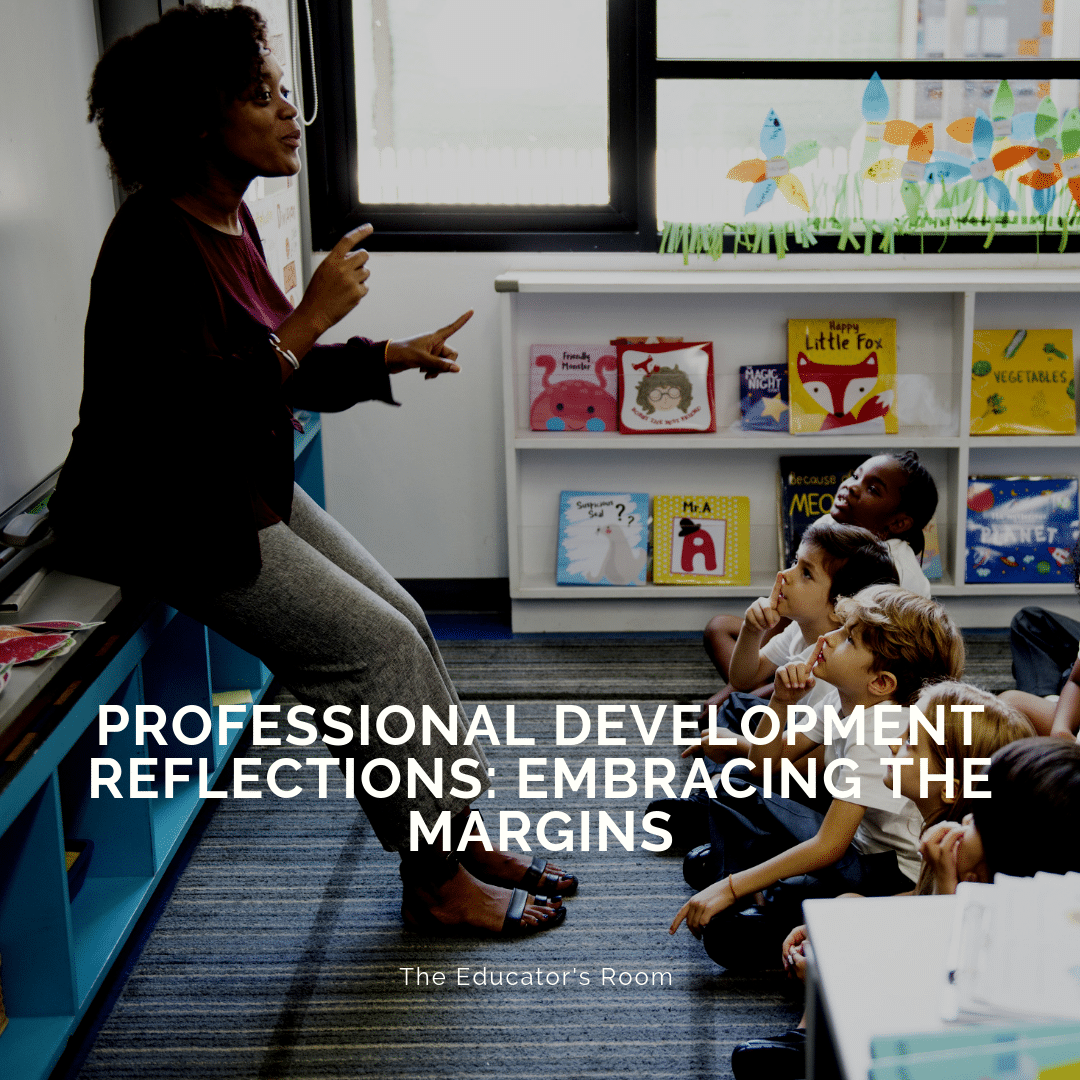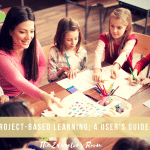Professional development, also known as PD, can often be unpredictable. In the words of Forrest Gump, like a box of chocolates, you never know what you’re going to get. I often try to remember this when I’m designing PD myself as I want to ensure professional learning is intentional and useful for educators. We all know what it’s like to feel our time has been wasted and walk away without practical application. So, when I attended a writing PD not too long ago, I was skeptical.
This was actually a writing mini-con (mini-conference) designed by our curriculum department and great teachers across the district. And I must say, anytime teachers are allowed to help create and curate professional development, it’s usually productive and rich in content. I left inspired and found it a blessing to have a day of writing while seeing a variety of ways we can spark this same inspiration in students. The day prompted me to think about how we “Embrace the Margins” in our classrooms and with our students.
On the Margins
Our morning writing activity centered around using songs or poems to spark writing with students. I loved the pieces that were shared with us and was amazed by the type of writing it sparked in us all. We were given two pieces, “…Or Forever Hold Your Peace” by Matilde Bernabei and “On the Margins” by Guy Farmer. After reading and listening to the pieces, we were asked to write however we felt led.
CHOICE
I love that we were given a choice to write however we felt led. How often do we allow students to do that? I know that in the true life of teaching we are running against time. All the time. Nonetheless, I feel the greatest benefit to students is the exposure and time given to immerse themselves in rich content. Less truly is more in developing students’ motivation to write. Simplicity works as well. Here are two pieces. Let them sit with you. Now, what are you led to write about?
My Choice
The poem, “On the Margins” sparked a particular interest for me as I have a heart for social justice and cultural responsiveness.
On the Margins by Guy Farmer
Living on the margins,
Surviving moment to moment,
Ignored by almost everyone
Except for the very few
Who understand that
They might have been
That very person.
This poem made me reflect on those who are usually forgotten; especially in our current social climate.
My Piece
This is the piece that I wrote after reading the poem……or as I like to call it “my random stream of consciousness”:
I often think of those who live in the margins. Those who are seemingly forgotten because the middle of the page is where the majority dwells. The majority is the focus, the standard, and who many want to see. The priorities of the majority are front and center. Sages on the stage. And isn’t it funny what we do when we need more space in the middle? We decrease our margins. We change our settings from 1 inch to 0.5. We slowly squeeze out the margins, not considering what was really there because WE, THE PEOPLE need more space for ourselves. WE, THE PEOPLE decide if or when or how the margins are diminished or eradicated. WE, THE PEOPLE have the choice and choose to make the gap W — I — D — E — R. I wonder what happens to those in the margin? Do they fall off the edge? Do they cringe as they are being squished? Do they leave quietly and harbor a deep rage?…or do they accept that they are the margins? Do they accept the setting changes because they know they never really had a place on the page? Do they lose their voices because of the line that separates them from the middle? What if WE, THE PEOPLE removed the line? Removed the margins completely? Wouldn’t we all have room on the page to share our stories for all to see?….and be sages on the stage together…in harmony.
Unexpected
One of the neat things I realized when I looked over my piece, were the opportunities for teachable moments even in its imperfect state. If I were to share this piece with students, I could have prompted a discussion about certain elements I used and why. Students may have noticed (or be guided to notice):
- repetition (Do they…../ WE, THE PEOPLE)
- an allusion (WE, THE PEOPLE)
- sentence variation
- stylistic letter placement
We then could have discussed those elements.
- What is my message?
- How did __________________ (insert element) enhance my message?
- What did this element add to my piece?
- Is there anything I could have added? Is there something I need to remove?
……the possibilities are endless.
These discussions could have prompted students to explore their own writing to find sweet nuggets of literary elements they didn’t know they used. One of the best parts of this was that I simply wrote. I wasn’t given a prompt. I didn’t have a rubric list of a million elements to add. I didn’t plan an outline or draft, but I let my words and thoughts lead without worry of where they would take me. Reluctant student writers may feel…
- that they don’t have anything to say
- that they cannot create meaningful pieces
- that they are not able to incorporate style or make stylistic choices in writing
- that their thoughts are not worthy of being in the middle of the page
…….however, we know THEY CAN do all of these things and their thoughts ARE WORTHY. Students just need the time and the space.
My Takeaway
I wasn’t planning to share anything I wrote that day, but after this writing time I felt a nudge to do so. I’m not sure what it was, but I had something to say and I said it. In thinking about students, it’s common to hear how reluctant or apathetic students can be when it comes to writing….and shall I dare say, to SHARE their writing. I wonder if we’re not creating enough space for students to feel they have space to write. To share. How often to do we give students time to allow a piece to speak, and for them to act on that spark? I wonder if we are sometimes so focused on getting through all the content that we stifle their voices; leaving students in the margins. How often are we creating a line that silences their voices? Beyond cultural application, there are many instances I feel we are leaving students in the margins to make more room for the middle (whether that be certain units or time constraints in the classroom). Let’s face it, many of us fear that if we don’t serve students the same dish in the same format…they just might falter when being assessed. However, if writing is part of the culture, embedded in the very threads of our classroom environment, how much more would students desire to write? How much more would they show on their assessments if they have a habit of creating meaningful pieces? In the article, “Writing Across the Curriculum: What, How, and Why,” Deva Dalporto, from WeAreTeachers, states,
In addition, studies have shown that writing helps boost student achievement across the board because it actively engages children. It requires them to take in information, organize their thoughts, sort through all of the information they’ve received and then process it. Writing is the most extensive brain workout a kid can get. It includes reading, logic, motor coordination and if writing for an audience, social emotional intelligence.”
How can we embrace those in the margin?
How can we take students who are on the edge, in the margin, silenced, reluctant, lacking confidence, and make space for them in the middle of the page? In reflecting over my teaching, I’ve learned that these types of writing experiences on a regular basis allow students to grow as writers (versus repeated prompts that force their thoughts into prompted questions or a certain number of lines). Students who are used to having agency, time, space and exposure to a variety of rich texts are more likely to form a habit of great writing. The culture of writing in our classrooms has the potential to grow, and the environments in which writing is cultivated must be protected and maintained.
[bctt tweet=”Students who are used to having agency, time, space, and exposure to a variety of rich texts are more likely to form a habit of great writing.” username=””]
Embrace the margins, not the barriers
I know all too well, as I have not lost my teacher hat, that many are thinking of the barriers that can prevent us from nurturing authentic literacy in students. Testing. Standardized testing is one major “barrier” that can steal authenticity and even our instructional time. While this is a real consideration, I have a call to action for educators:
Nonetheless, embrace the margins.
As expressed in my writing piece, the margins are often overlooked, pushed away, discarded, and forgotten. In education, we have a tremendous amount of barriers, yet we are the true keepers of our students. There are moments where what we know is best must trump the status quo. There are moments that require bravery from us in a system that can often penalize us for offering what students need most. I implore you to embrace the margins by embracing ALL students and giving them authentic opportunities to engage in their content. Writing is a powerful tool that can orchestrate lives and influence the world. It’s easy to get caught up in the checklists, pacing guides, expectations, and whirlwind of the “business of school.” However, there’s much more to offer our students than a pre-packaged education. We hold a generation, a democracy, and futures in our classrooms of which we can not afford to continue to decrease those margins.
This mini-con was powerful in that it reminded me of just that. Our charge to give students what we know they need and can have. A reminder to slow down. A reminder to be intentional about creating meaningful learning experiences such as these. A reminder to embrace the marginalized whether they are reluctant readers, writers, or are marginalized culturally and socially. It’s our duty to widen their margins and spaces; not decrease them.
I don’t believe students hate writing as much as they proclaim. I simply believe they just have not found their space on the page.






